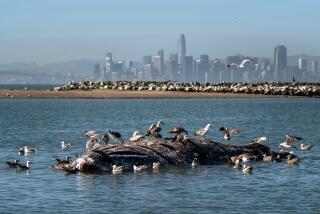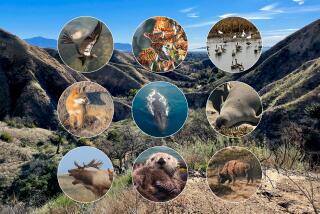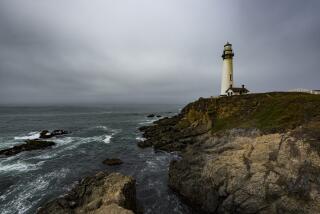ALASKA...AWESOME!
- Share via
GLACIER BAY NATIONAL PARK, Alaska — Some people think families should work like democracies. Our family, however, resembles a benign dictatorship in which adults set the rules. This includes travel plans.
And so it came to pass that the three of us decided to spend our family vacation in Alaska’s popular Inside Passage. The idea was mine, made possible by a gift from a travel-loving relative. My husband, Don, was also enthusiastic, though he pointed out that we could have gone to Europe for what we spent on air fare alone from our home in New Mexico. However, our son Brandon, who was 12 at the time, is a kid who lives for sports, and he had his own idea of a good vacation: Basketball camp.
Brandon was outvoted.
We worried he’d be bored, but we also knew that he had enough natural curiosity to enjoy the adventure. And in exchange for a minimum of whining, we promised to find places where he could play basketball so that he’d have a better chance of making the seventh-grade team when school started in the fall.
In late July last summer, we flew to Juneau, where we visited the Mendenhall Glacier and spotted salmon-hunting eagles (and where Brandon and his dad found a youth center where they could play one-on-one basketball). After two days there, we headed to the highlight of our trip: Glacier Bay.
From Juneau, it was a half-hour flight to the Gustavus airport, which exists mainly to accommodate visitors to Glacier Bay National Park and Preserve. The park, across the mountains from the picturesque community of Haines (famous for its bald eagle preserve) can be reached only by air or sea.
Explorer George Vancouver would have discovered Glacier Bay in 1794, when he arrived at nearby Icy Strait, except that two centuries ago there was no Glacier Bay. The site where the Park Service headquarters building now stands was then beneath a glacier more than 4,000 feet thick and up to 20 miles across. The ice floe extended more than 100 miles, stretching up into the Fairweather Range and across what is now the Canadian border.
Vancouver described what became Glacier Bay--a place whose beauty has since inspired the poet in many a scientist--as an nondescript indentation in a huge river of ice.
Most people from the Lower 48, about 200,000 a year, visit Glacier Bay by cruise ship. But we chose to spend a couple of nights at the park’s Lodge at Glacier Bay, at Bartlett Cove, and explore at our own pace. The rustic inn, built in 1966 amid spruce and hemlock trees, has a restaurant, a gift shop, an inviting stone fireplace in the lobby, and an extended wooden deck looking out toward a dock. Elevated wooden walkways connect clusters of cabins and dormitories. When we arrived in the late afternoon, the waters of Bartlett Cove glistened through the lodge’s main windows, and the air was rich with damp, green smells.
Our clean, comfortable cabin had two double beds, functional pine dressers and windows that let in a symphony of bird songs. Brandon moped a little because there was no TV, then spread out on his bed with a supply of sports magazines he had brought. He alternated between reading and jogging to the lodge and back. (He had also brought along a carry-on with 40 pounds of free weights, but he never unpacked them. He said he got enough exercise just carrying them through airports and hotels.)
Because the glaciation here is so recent in terms of geologic history, the park offers a living laboratory in which to study the ways that plants and animals begin to populate an empty area. If you stay at the lodge, the lab begins at your doorstep.
After we unpacked for our two-night stay, we took a short hike out to the water. The fern-like leaves on the tall trees glistened with spider webs. Moss hung from the branches and, here and there, cream-colored fungi clung to the bark. We encountered two hikers who told us they’d seen a black bear eating berries just off the trail. Brandon volunteered for an important job: making noise to warn bears that we were in the area.
*
As we moved out of the forest, a thick undergrowth of berries and flowering plants gave way to waist-high grass. The trail disappeared into a broad shore of slick, rounded rocks--smoothed by the glaciers’ force. Brandon found a treasure, a piece of thick amber-colored kelp as long as a garden hose. It made a perfect whip.
After a tasty but expensive dinner of smoked salmon and halibut, fish and chips, seafood chowder and salads ($95 for three!), we took a look at the visitor information center. I hoped for a preview of what we’d see on our trip to the glaciers in the morning.
The National Park Service runs a rather old-fashioned operation here, designed for people who read rather than push buttons. The center displays preserved examples of the area’s plants and animals, and offers albums thick with photos and explanations of the flowering plants, fungi, trees, birds and mammals that visitors might encounter. A film and slide shows supplement the displays, and rangers lead two hikes daily, rain or shine.
The land around the lodge is strikingly beautiful. But no matter where you walk, you won’t get even a peek at a glacier from Bartlett Cove. The nearest, I was disappointed to discover, are 70 miles from the lodge. To see the glaciers, you need a boat.
*
A little before 7 a.m. the next morning, we boarded the Spirit of Adventure, a 200-passenger catamaran that took us on an eight-hour glacier tour.
Because I am prone to seasickness, I was pleased to discover, as we headed into Glacier Bay, that the seas were calm, apparently a normal condition in these waters. Not so normal was the weather: We lucked out with an unusually warm, clear day. The high would reach 70; the average for late July is 55.
Our tour was narrated through a shipboard loudspeaker by Park Service naturalist Matt Cahill. Just 20 minutes into the ride, he pointed out two columns of vertical mist: humpback whales spouting. Scores of binoculars scanned the water.
Unlike passengers who’d staked out comfy spots inside, Don and I stood on deck at the railing, enjoying the brisk morning air. (Brandon was investigating the snack bar and looking for the free hot chocolate.) We saw a broad, gray back in the blue water. Then, from the another whale, the characteristic humpback tail fin waved like a salute as the whale submerged.
We looked for Brandon. Don found him inside, hunched over a morning cup of hot chocolate. He asked Brandon if he wanted to come up and look at the whales. “It’s cold out there,” he grumbled in typical preteen fashion. Later, however, we noticed him standing with another group of tourists, watching the bay. Someone had loaned him a pair of binoculars.
With Cahill’s help, we spotted a group of sleek orcas, also called killer whales. Like the humpbacks, they were so far away that they looked small, even through our field glasses. We passed a mother grizzly bear and three cubs eating berries on the shore. We saw birds of many varieties: oystercatchers, loons, gulls, kittiwakes, eagles and bulky pigeon guillemots struggling to get airborne. More than 200 kinds of birds live here, feasting on the abundant marine life. Humans are the minority species.
Most of Glacier Bay, which has 3.3 million acres, became a national park in 1925. The park, open only in the summer because of Alaska’s climate, protects one of the largest concentrations of tidewater glaciers on Earth--16--and boasts one of the highest coastal mountain ranges in the world, with many peaks over 10,000 feet high.
It took about five hours, with pauses for viewing marine and shore life, to go from the dock at Bartlett Cove to the end of the west arm of the bay, where the Grand Pacific and Margerie glaciers make passage impossible. The boat stopped here so we could take a long look at them.
Glaciers form when mountain snowfall consistently exceeds snowmelt. The snowflakes first change to granular snow--corn snow, skiers call it--but the accumulating weight soon presses them into solid ice. Eventually gravity and pressure set the ice mass flowing down. Southeast Alaska has the perfect climate for glaciers, and scientists have come to Glacier Bay to study for more than a century.
Glaciologists talk about the glaciers as if they were living things: They move, collect debris, merge with other glaciers as they travel, deposit a moraine, or barrier, of rock to protect themselves from the erosion of the water, and calve, or break into icebergs.
When John Muir came here in 1879, he found that the ice had retreated 48 miles from where Vancouver had observed it, creating Glacier Bay. He described the place as “icy wilderness unspeakably pure and sublime.” He also wrote that it was “beyond description,” but he spent the next 300 pages trying to describe it.
Today, glacial retreat continues on the bay’s east side, but on its west side, closer to the Fairweather Range, glaciers are advancing. No one is quite sure why.
*
The Spirit of Adventure stopped about a quarter-mile from the glacier’s face. For perhaps an hour we stood on deck, watched and listened. Even Brandon, who had been hanging out at the snack bar pretending he didn’t know us, appeared on deck and asked us for the binoculars. First came the explosive cracking of the ice, then the noisy splashes as huge chunks of white, blue or dark ice crashed into the water. Next, the air reverberated with the screech of swooping birds as they rushed to eat the sea life brought to the surface by the impact of the ice hitting the bay.
For safety reason, the Spirit of Adventure doesn’t disembark passengers to walk on the glaciers (a “cold way to die” is how one park ranger put it). I was disappointed but understood the logic.
All ice, we learned, is not alike. Glaciers carry their history with them. The blue color most commonly associated with glaciers--a sheen the shade of the “blue ice” we buy for our cooler--comes from the ice’s compaction. Blue is the only wavelength from the light spectrum that escapes. Black ice gets its color from the tremendous amount of debris it carries. When two or more ice floes intersect, they create a stratified glacier, telling the story of their merger as clearly as marbled cake batter. White ice contains the most air bubbles. Greenish or blackish bergs usually have calved off the bottoms of glaciers. Algae gives some ice a reddish tint.
On the cruise back to the Bartlett Cove, we saw harbor seals; they congregate in narrow inlets where the icebergs provide platforms for the females to give birth to their pups and protect them from orcas.
*
The next day we saw more whales, this time in Icy Strait. Brandon went with us in good spirits, cheered by the announcement that after today we’d be back in Juneau and he could play basketball again. Our son was successfully resisting Alaska’s effort to turn him into a budding naturalist.
The whale tour, aboard a 78-foot catamaran, featured naturalist Emma Deerkiller, who intertwined information from her own Tlingit heritage with facts about the animals. Auk Nu Tours provided binoculars for passengers. The captain had a good idea of where to find the whales and invited Don to photograph from the wheelhouse. The weather was closer to what we’d expected of Alaska: a cool mist, concrete skies and patchy fog that blocked the view of the blue, tree-covered islands.
As we left the dock at Gustavus, Deerkiller advised that animals don’t seem to mind the click of cameras but that human voices scare them. The quieter we were, the better the chance of getting pictures and memories to take home. We all complied.
One of the largest concentrations of humpback whales in all of Southeast Alaska occurs at Pt. Adolphus, just outside the entrance to Glacier Bay in Icy Strait. The whales feast on the rich soup of these plankton-filled waters before migrating to Hawaii for the winter. The abundance of fish nourishes other wildlife as well.
Deerkiller said an estimated 10,000 bald eagles nest in southeastern Alaska. The boat approached an eagle nesting tree and, as if on cue, the sun broke through and gray water turned blue. We spotted the fuzzy brown fledgling and the white-headed parent perched a little higher in a nearby tree.
The crew offered the passengers free clam chowder, hot drinks and baked-on-board cookies.
Then we spotted the vapor spouts of humpbacks.
The captain killed the engine, and Deerkiller signed off the microphone. We floated, expectantly. We heard the vigorous whoosh of their spouting several more times, then saw the smooth, rounded triangles of the dorsal fins. Six whales frolicked, unconcerned about our little boat. Brandon joined Don in the wheelhouse, not only for a better view of the whales but to get a look at the boat’s electronics.
We watched the whales dive and resurface, flashing their fan-like flukes. Finally, the whales and the boat drifted apart and we cruised a little farther toward Chichagof Island. We spotted the tall, slim dorsal fin of a male orca, and, soon afterward, a family pod: male, female and a young whale traveling closely together.
Two younger males tagged along at a distance. The orcas leaped, their black-and-white bodies perfectly sleek, perfectly in tune with their environment. They rolled on their backs. They splashed exuberantly. The older male seemed to stand on his tail, lifting his huge head out of the water--a position known as spy hopping--to take a look at us while we watched him. Entranced, the passengers migrated from one side of the boat to the other to get the best view. No one spoke. Even Brandon lost his glum face. He looked as happy as if he’d made a 3-point shot.
Finally, the boat had to head for the dock so that those of us who were leaving could pack up and make it to the airport for the trip back to Juneau. If those orcas had a whale of a good time, well, so did we. And, despite our Alaska adventure, Brandon made the basketball team.
(BEGIN TEXT OF INFOBOX / INFOGRAPHIC)
GUIDEBOOK
Glacier Bay Watch
Getting there: To fly to Gustavus, gateway to Glacier National Park, Alaska Airlines is the only choice. From Southern California, there is a change of planes in both Seattle and Juneau. Advance purchase, round-trip air fare begins at $542.
Where to stay: The Lodge at Glacier Bay (Department VP, 520 Pike St., Suite 1400, Seattle, WA 98101; telephone [800] 451-5952, fax [206] 623-7809), is the only lodging in Glacier Bay National Park. Rates: $78 per person based on double occupancy; dorms are $28 per person.
There are several B&Bs; and small hotels in little Gustavus, a half-hour drive from the park. Contact the Alaska tourism office.
Tours: Glacier Bay Tours and Cruises (tel. [800] 451-5952), a park concessionaire, offers eight-hour Glacier Bay tours; ask for packages that combine tours of the area. Auk Nu Tours (tel. [800] 820-2628, fax [907] 586-1337; advance reservations recommended) offers daily whale-watching cruises, mid-May to mid-September. Cost: $78 per person for a half-day tour.
For more information: Alaska Division of Tourism, P.O. Box 110801, Juneau, AK 99811-0801; tel. (907) 465-2010. Or Glacier Bay National Park, P.O. Box 140, Gustavus, AK 99826-0140; (907) 697-2230.
More to Read
Sign up for The Wild
We’ll help you find the best places to hike, bike and run, as well as the perfect silent spots for meditation and yoga.
You may occasionally receive promotional content from the Los Angeles Times.






